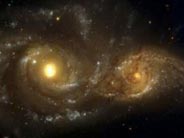NASA telescope spots two mega solar systems
Scientists have found evidence of two mega solar systems giant stars enveloped by what appear to be huge disks of planet-forming dust, they said Wednesday.

The appearance of cloudy disks around stars are believed to represent current or future planetary systems.
Our sun is surrounded by the Kuiper Belt, a disk containing dust, comets and other bodies.
Astronomers say the latest findings through NASA's Spitzer Space Telescope were surprising because such massive stars are thought to be inhospitable to the formation of planets.
"Our data suggest that the planet-forming process may be hardier than previously believed, occurring around even the most massive stars," Joel Kastner of the Rochester Institute of Technology, said in a statement.
Results appear in the Feb. 10 issue of the Astrophysical Journal Letters.
The new stars are believed to be 30 to 70 times more massive than the sun. Because of the stars' size, scientists say the surrounding debris disks are larger versions of the Kuiper Belt and probably contain about 10 times more mass.
The new stars were found during a survey of 60 bright stars. Kastner said the new discoveries stuck out from the rest because an analysis indicated the presence of flat disks.
Last year, another team of scientists discovered what they believe was a mini solar system. The team found a dust cloud around a brown dwarf, or failed star, reports AP.
O.Ch.
Subscribe to Pravda.Ru Telegram channel, Facebook, RSS!


